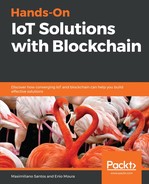IoT plays an important role in the food chain. IoT devices can track assets, and there's an arsenal of models available that can do that. There are sensors for measuring temperature, and location can be determined using GPS, beacons, SigFox, Wi-Fi, 4G, and Sub1Ghz. These devices and networks can be used by farms, factories, transportation companies, distribution centers, and retail outlets, covering all actors in the food chain.
The major challenge in the food chain is transportation. Many foods require special care, and temperature is one of the most important concerns. Since many foods are perishable, and temperature control is vital for preventing contamination and damage.
Let's take a look at how we can mitigate this challenge using an IoT-enabled device. The Particle Electron Asset Tracker (pictured in the following diagram) can be used to collect temperature and environmental data and identify GPS location and cellular triangulation, among other things:

This tracker allows us to connect with a u-blox M8 GNSS GPS receiver and Adafruit LIS3DH Triple-Axis Accelerator. We can connect Grove sensors to it as well.
Let's look at a high-level architecture of this kind of IoT solution:

This diagram shows us some important components of the solution. Let's see what they are:
- Message Queuing Telemetry Transport (MQTT): This refers to a publish-subscribe-based messaging protocol that works over TCP. It's designed for connections with remote locations where a small code footprint is required or the network bandwidth is limited. The publish-subscribe messaging pattern requires a message broker.
- Node-RED: Node-RED is a programming tool for wiring together hardware devices, APIs, and online services in an easy way using a flow editor that can create JavaScript functions.
- IBM Cloud: This is a set of cloud computing services for business.
- Bosch IoT Rollouts: This is a cloud service in the Bosch IoT Suite that enables users to manage the rollout of software updates to edge devices, controllers, and gateways.
So, how do these components come together to assist in the various processes in the food chain? Here's how:
- The Node-RED control panel dashboard enables us to select an asset tracker and check the location, data, device status, and other information
- The asset tracker device can be either activated or updated over a cellular network
- Geolocation data can be transmitted periodically and can be followed by a dashboard in Node-RED, for example
- The asset tracker device queries the temperature data and then may query for location or velocity data
- Node-RED can write the temperature, location, and velocity data to Hyperledger Fabric
- The Node-RED dashboard queries Hyperledger Fabric for various tasks and information, such as transaction histories, date and time data, and geo-sensor data
